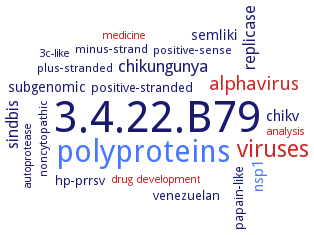3.4.22.B79: nsP2 protease
This is an abbreviated version!
For detailed information about nsP2 protease, go to the full flat file.

Word Map on EC 3.4.22.B79 
-
3.4.22.B79
-
polyproteins
-
viruses
-
alphavirus
-
chikungunya
-
replicase
-
sindbis
-
chikv
-
nsp1
-
semliki
-
subgenomic
-
positive-stranded
-
venezuelan
-
hp-prrsv
-
papain-like
-
noncytopathic
-
plus-stranded
-
positive-sense
-
minus-strand
-
analysis
-
3c-like
-
drug development
-
autoprotease
-
medicine
- 3.4.22.B79
- polyproteins
- viruses
- alphavirus
-
chikungunya
-
replicase
-
sindbis
-
chikv
- nsp1
-
semliki
-
subgenomic
-
positive-stranded
-
venezuelan
-
hp-prrsv
-
papain-like
-
noncytopathic
-
plus-stranded
-
positive-sense
-
minus-strand
- analysis
-
3c-like
- drug development
-
autoprotease
- medicine
Reaction
the enzymes processes the alphavirus nonstructural polyprotein (nsP1234). The enzyme from Venezuelan equine encephalitis virus shwos a preferens for Gly or Als in position P1', Ala or Cys in P1, and Gly in P2 =
Synonyms
non-structural polyprotein 2, nonstructural polyprotein, nonstructural protein, nonstructural protein 2, ns polyprotein, nsP2, nsP2 protease, nsp2 protein, nsp2pro, p39 nsp2 protease
ECTree
Advanced search results
Crystallization
Crystallization on EC 3.4.22.B79 - nsP2 protease
Please wait a moment until all data is loaded. This message will disappear when all data is loaded.
homology model of nsP2 protein based on the crystal structure of the nsP2 protein of Venezuelan equine encephalitis virus and proposal of the the pharmacophore features that must be present in an inhibitor of nsP2 protease
molecular dynamics simulation and virtual screening of inhibitors based on PDB entry 3TRK leads to identification of top hit compounds, together with the five potential binding pockets of the nsP2 protease. Pocket 4 in the N-terminal domain of the nsP2 protease has been identified as the active site by the presence of catalytic residues, Cys1013 and His1083
molecular dynamics simulations and comparison with papain. The active site scaffold is the same in both the proteases. The two structurally identical segments in both the proteases show considerable difference in terms of their mobility
to 2.59 A resolution. Protein consists of an N-terminal protease subdomain and a C-terminal methyltransferase subdomain. The substrate binding cleft is present at the interface of two subdomains. Access to the active site and substrate binding cleft is blocked by a flexible interdomain loop. This loop contains His548, the catalytic residue, and Trp549 and Asn547, the residues predicted to bind substrate
hanging drop vapor diffusion method, using 12%(w/v) PEG 8000, 10%(v/v) ethylene glycol, 100 mM HEPES pH 7.5
-
structure of nonstructural protein P23 in a precleavage form. The proteins form an extensive interface and nsP3 creates a ring structure that encircles nsP2. The P2/3 cleavage site is located at the base of a narrow cleft and is not readily accessible. The nsP2 protease active site is over 40 A away from the P2/3 cleavage site, supporting a trans cleavage mechanism. nsP3 contains a previously uncharacterized protein fold with a zinc-coordination site. Known mutations in nsP2 that result in formation of noncytopathic viruses or a temperature sensitive phenotype cluster at the nsP2/nsP3 interface
at 2.45 A resolution. Belongs to space group P212121. N-terminal domain (Asp468 to Asn603) contains the catalytic dyad formed by Cys477 and His546, organized in a protein fold. C-terminal domain (Arg604 to Ser793) contributes to substrate recognition and regulates the structure of the substrate binding cleft
combination of molecular dynamics simulations with structural studies. The catalytic mechanism of the nsP2 protease appears similar to the papain-like cysteine proteases, with the conserved catalytic dyad forming a thiolate-imidazolium ion pair in the nsP2-activated state. Substrate binding likely stabilizes this ion pair. Protease residues His510, Ser511, His546, and Lys706 are critical for cleavage site recognition. Structural determinants of substrate specificity that recognize features common to all three cleavage sites within the viral polyprotein are strongly conserved among alphaviruses. Contacts between S2/P2 and S3/P3 residues illustrate preserved binding motifs such as the ubiquitous P2 glycine interaction with Trp547 and hydrogen bonding between P2 and His510


 results (
results ( results (
results ( top
top





